Episode 202
What you’ll learn in this episode:
- How Kristen decided to start the next phase of her career at Scotland’s University of Dundee
- Why metalsmithing and jewelry attracts people who like a challenge
- How creating jewelry can be like creating an opera
- What young jewelry artists can learn by entering competitive exhibitions
- Why curiosity can help artists overcome shyness and fear
About Kristin Beeler
Kristin Beeler joined the faculty of Duncan of Jordanstone College of Art and Design at the University of Dundee, Scotland UK in 2023.
From 2002-2023, she was Professor of Art and Coordinator of Jewelry and Metalwork at Long Beach City College in the Los Angeles, California area. She is native to the Blue Ridge Mountains of central Appalachia and is a second generation graduate of historically interracial and craft-centered Berea College receiving a BFA in Crafts and Applied Design with a minor in Philosophy (1989). Her Master of Fine Arts in Jewelry from the University of Arizona (1994) was followed later by post graduate studies at Alchemia Jewellery School in Florence, Italy (2011) and Atelier Rudee, Bangkok, Thailand (2013).
Solo exhibitions include Integumentum 2021 at Baltimore Jewelry Center, Baltimore, Maryland, Archive of Rag and Bone at Mesa Contemporary Arts Museum, Phoenix, Arizona (2016) and Beauty and Other Monsters at Velvet da Vinci Gallery, San Fransisco, California (2007).
Additional Resources:
- Kristin’s Website
- Kristin’s Instagram
- Duncan of Jordanstone College of Art and Design
- The Jewellery and Metal degree programme at Duncan of Jordanstone College of Art and Design Instagram
- Long Beach City College Metalsmithing
- IG:@lbccjewelryandmetalwork
- https://thestrawfactory.com/
- IG:@straw.factory
Photos:
Kristin Beeler in the studio
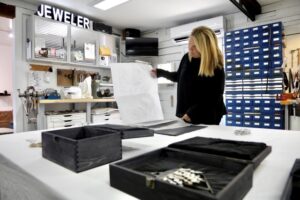
bc1.A and bc1.C
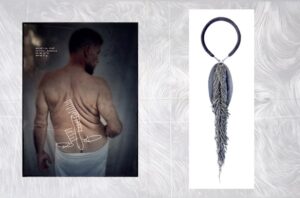
pp1.C2
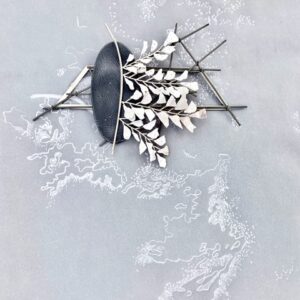
pp1.C1 and worn
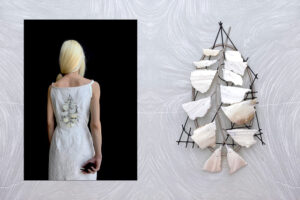
mc1.A and mc1.B
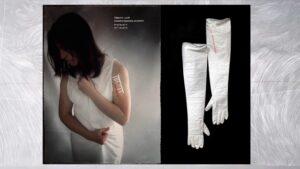
Magdalena’s Pearls
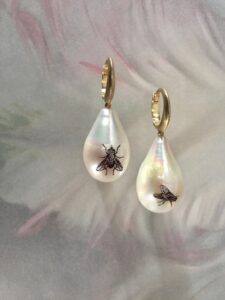
Transcript:
After two decades as a professor at Long Beach City College, artist and jeweler Kristin Beeler is heading back to school herself at Dundee University in Scotland. Although any international move comes with fear, Kristin has relied on a sense of curiosity to keep pushing her work froward. She joined the Jewelry Journey Podcast to talk about why certain artists are drawn to metal; how she tries to create context through her work; and why some of the most important lessons she learned were from submitting her work to competitive exhibitions. Read the episode transcript here.
Sharon: Hello, everyone. Welcome to the Jewelry Journey Podcast. This is the second part of a two-part episode. If you haven’t heard part one, please head to TheJewelryJourney.com.
If you look at Kristin Beeler’s jewelry, she looks like she’s a risk taker, but that’s not really true. She has followed a well-worn path, but she also has risk in her work. She received her master’s and then became a professor of art at Long Beach City College. She teaches both metal arts and jewelry. She is the Coordinator of Jewelry and Metalwork for Long Beach City College. Welcome back.
Did you have to do a lot of looking to find a school like that in the U.S.?
Kristin: It was a school my mother went to, so I was second generation.
Sharon: Wow! What are your thoughts about metalwork versus jewelry arts? I saw that you did some gloves in Tyvek. It was hard to pin down what you do because it’s very esoteric. It has a lot of meaning. I kept asking, “Why this?”
Kristin: The work I do is more driven by an idea and trying to build a full context for an idea. The jewelry is part of that context. It’s a bit like going to the opera. I love opera, and I love it because it’s a full context. The stage is opera. The music is opera. The singing is opera. The costuming is opera. It is all of those things, and those things come together to produce this one idea. I wouldn’t say my work is theatrical, but I think it has some operatic qualities when it works well. It’s not meant to follow one particular pathway because, as I said, not everything is a piece of jewelry. Some things are meant to manifest through other things, and jewelry is a part of that.
Sharon: I see that you’ve been in a lot of competitions, where your jewelry is judged. Do you have trepidations? I can’t imagine doing anything like that.
Kristin: It’s really hard at first. It’s one of the hardest things to get my students to do because when you do it, the risk of failure is huge. You’re going to be rejected, but it is such good practice. That’s what being an artist is about: trying to find the place where your work fits, and if your work isn’t fitting into the place you want to go and into the trajectory you want, figuring out how to make it go into that trajectory. It makes shifts to what you’re working on.
I haven’t done it in quite a long time; most of what I do now is invitational work, but I do find it interesting to enter competitive exhibitions. It does a couple of things. Usually if I’m applying for a competitive exhibition, it could be because I want to get my work in front of a juror, or it’s in a location where I want to go, where I have friends. Or it’s a theme I like and I find interesting. But I had to go through a period of doing it and becoming O.K. with someone saying no and doing it anyway. When I was in graduate school, I was told, “Be prepared to wallpaper your room with rejection letters. Get rejected as much and as often as you can because it is a skill to build up and not let that stop you.”
Sharon: Are you ever rejected if it’s invitational?
Kristin: If it’s invitational, it’s because they’ve seen my work and they want something in particular.
Sharon: That must have been a big hurdle in the beginning. To be rejected must have been a big hurdle.
Kristin: It probably was. Looking back on it now, it’s funny. I was silly to be so worried about that. I think I was lucky that my work was pretty readily accepted. I think I did quite well. Even going into this new career—I’m basically going into a second career—there are moments when I think, “I don’t know if I can do this. What was I thinking?” and I can go back to those moments previously where I tried to do something where uncertainty was guaranteed, or I didn’t know how it was going to work out. I can say, “Well, I did that, and it worked out O.K.”
Sharon: Did SNAG help you? You were on the board of SNAG. Why don’t you tell us what it is?
Kristin: The Society of North American Goldsmiths is the organization for the field. I have worked with SNAG since 1999 or 1998. That was when I first started volunteering for them. I started working with SNAG because I would go to the conferences at the encouragement of my graduate faculty, and I was kind of terrified. There were a lot of people there whose work I would see in publications or I’d hear about them. I was quite shy, so the easiest thing for me to do was offer to volunteer for something. If I don’t know what to do, I’ll work, so volunteering was a perfect thing to do. It was intuitive.
It wasn’t planned at all, but I met so many interesting people by volunteering at the conferences. They would say, “Oh, would you be able to do this?” and I would say, “Well, yeah,” and then I would meet more interesting people. I don’t know that it was a great expansion time for my work because there are only so many hours in the day. When you’re putting your energy out for one thing, it’s not necessarily going in the other direction. So, I don’t know that I was accomplishing as much in my studio, but I was meeting really, really interesting people and having some really interesting conversations. I think that that was one of the most valuable things about being involved with SNAG, just getting to know the community in a deep way.
I served on the board of SNAG for five years between 2001 and 2005. I’ve had some job with SNAG almost every year since then, some small thing, helping with exhibitions. I have worked with the Diversity, Equity, Access and Inclusion Committee. I have worked with the Educational Endowment Committee. Currently I serve as trustee for the SNAG Educational Endowment Scholarship Trust. That is my primary role with SNAG at this point.
Sharon: Do you recommend it to your students as a way to learn about the field?
Kristin: Always, yeah. That and listening to Jewelry Journey.
Sharon: I don’t know about that. I was thinking about you listening to other people’s opinions. I once heard someone say that they felt they had to know who the artist was before they could wear the piece of jewelry. I just felt like, “Well, is it pretty? Do I like it?” and that sort of thing. That’s why I would be intimidated.
Kristin: It was interesting to humanize all of those things. Often the work can be much richer once you have a better idea of the person who made it. It can alter your perspective on pieces to know who made it. Sometimes you might not want to know, but I think one of the great blessings of this field is that it is full of generous and warmhearted people who are so willing to share what they know.
Sharon: Do you consider yourself one of those people willing to share what you know?
Kristin: I hope to be, yeah.
Sharon: I’m struck by the fact that you say you were shy, because you don’t come across that way at all. Does that present itself in your reluctance in going abroad and when you started teaching? Was that a concern?
Kristin: Yes, I was pathologically shy, but more than that I was curious. I think curiosity trumps those reluctances if you allow it to. Being curious takes you outside of yourself. You can become involved in other people’s stories and other people’s interests. When you change that reflection, then it’s much easier to get to know people and enjoy them. As I said, my go-to was to do some work and find other people who are doing work and just help them. Carrying the load together is always a good way of lifting yourself up as well.
When I started teaching full-time, I spent probably the first several years pretending to be someone who is comfortable in front of a classroom. I don’t know that I was, but I could pretend to be someone who was. I think going to Scotland, now that the challenge is there, it’s exciting and terrifying by turns, but I’m so curious. I always want to know what happens when you do this or what happens when I do this. Pulling into that curiosity is a life raft.
Sharon: Do you have a history with the country? Did your family come from there? Did you visit it a few times?
Kristin: No, I had never been to Scotland before I interviewed, but my family has lived in Appalachia for about 400 years.
Sharon: Where?
Kristin: Appalachia.
Sharon: Oh, 400 years, wow!
Kristin: Yes, so they have been there for a very long time. Many people from that area came from Scotland, England, Wales, Ireland, so Scottish history was something we grew up with because of this strong connection to Scottland and Ireland. The music that was local to where I grew up came straight from Scottland. The local dances, the crafts in particular. Things that had been brought 400 years earlier were still practiced, and a lot of those skills came from Scottland.
Sharon: Do you lie in bed at night, or are you grocery shopping and an idea comes to you and you start on it?
Kristin: For my studio practice?
Sharon: Yeah.
Kristin: There are probably two tracks to that. One is that it’s all a long inquiry that never stops. It‘s one little thing that leads to the next. It doesn’t have a beginning or an end. It’s kind of all in the middle and ideas roll in one direction or another. Pieces may not finish, but I’m committed to finishing bodies of work. I’m really terrible about it, actually. In terms of solutions—I think maybe what you’re asking about is solutions to particular problems—those are things that revolve as well. Sometimes I’ll see something, or I’ll be making something that doesn’t make sense in the moment, but I’ll just hold onto it. It’s like I’m looking for an answer to a problem. It’s like, “Oh, there it is in this book or in this drawer of samples I made.” If I waited for ideas to come to me, I’d be waiting a really long time. I have to go out and hunt for them. They’re constantly generating, but the solutions to problems plug in at different locations on a very long timeline.
Sharon: For instance, on some of the projects, whether you’re invited or you decide to enter a competitive situation, once that’s done, do you say, “O.K., that’s nice. That’s done. Now, I’m on to the next thing,” or is it done?
Kristin: These pieces often cycle in and out. Unless a piece is purchased, they all belong to this collection of pieces that are shown in different iterations. For group exhibitions, there may be between two and four pieces that are shown together, but for solo exhibitions, there’s a larger body of work. Every time I show that body of work, it may have different pieces in that collection that are shown.
Sharon: What happened to the gloves that are made of Tyvek? How did you come up with the idea of Tyvek?
Kristin: Oh, I love Tyvek. It is such a fun material. Certain materials just didn’t appeal to me, and I have all of these Tyvek mailers. I would get things in the mail, and they come in those Tyvek mailers. I saved all these mailers for years and thought, “I’m going to do something with them.” Then I realized you could just buy it. I had kept it because it has this beautiful, papery, silky quality to it which is really nice. It’s virtually indestructible until it’s not, so it has this strength but this vulnerability as well. I like that about it.
From time to time, I have made gloves over the years because I think they’re interesting objects. There’s such a strong relationship to the body and what we do with our hands. Those gloves in particular were designed with this young woman in mind who had this scarf. I already said I love opera, so having these opera-length gloves, I used a vintage pattern for that. I had her scarf embroidered on these very delicate but strong gloves that were kind of ethereal. That was perfect for my purpose.
Sharon: That’s interesting. I saw the pictures, but I wasn’t sure what it was. That’s very interesting. Thank you very much for being with us today. Good luck in Scotland. We’ll be reading about you.
Kristin: Thank you so much, Sharon. This was so fun.
Sharon: We will have photos posted on the website. Please head to TheJewelryJourney.com to check them out.
Thank you again for listening. Please leave us a rating and review so we can help others start their own jewelry journey.

